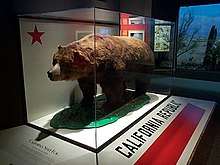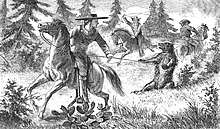California grizzly bear
| California grizzly bear | |
|---|---|
 | |
| Monarch, a preserved specimen, on display at the California Academy of Sciences. | |
| Scientific classification | |
| Kingdom: | Animalia |
| Phylum: | Chordata |
| Class: | Mammalia |
| Order: | Carnivora |
| Family: | Ursidae |
| Genus: | Ursus |
| Species: | U. arctos |
| Subspecies: | †U. a. californicus |
| Trinomial name | |
| Ursus arctos californicus Merriam 1896 [1] | |
| Synonyms | |
| |
The California grizzly bear (Ursus arctos californicus) is an extinct subspecies of the grizzly bear, the very large North American brown bear. "Grizzly" could have meant "grizzled" (that is, with golden and grey tips of the hair) or "fear-inspiring" (this is actually spelled "grisly").[2] Nonetheless, after careful study, naturalist George Ord formally classified it in 1815 – not for its hair, but for its character – as Ursus horribilis ("terrifying bear").[3] Genetically, North American grizzlies are closely related;[4] in size and coloring, the California grizzly bear was much like the grizzly bear of the southern coast of Alaska. In California, it was particularly admired for its beauty, size and strength. The grizzly became a symbol of the Bear Flag Republic, a moniker that was attached to the short-lived attempt by a group of American settlers to break away from Mexico in 1846. Later, this rebel flag became the basis for the state flag of California, and then California was known as the "Bear State."[5]
Nomenclature

A 1953 researcher stated, "The specific status of North American brown bears (or grizzly bears) is one of the most complex problems of mammalian taxonomy. The difficulty stems directly from the work of Merriam (1918), who concluded that there are 86 forms of grizzlies (and brown bears) in North America."[6]
North American grizzlies were taxonomically grouped as a species apart from other bear species, until DNA testing revealed that they should properly be grouped in the same species as the other brown bears.[4] Grizzlies living in California had been classified by Merriam into many subspecies, but the only genetically anomalous grouping in North America is the ABC Islands bears.[7]
History and extinction

The first recorded encounters of California grizzly bears by the Europeans are in the diaries kept by several members of the 1769 Portola expedition, first exploration by land of what is now the state of California. Several place names that include the Spanish word for bear (oso) trace their origins back to that first expedition (e.g. Los Osos).
As the settled frontier of New Spain was extended northward, settlers began to populate California and establish large cattle herds as the main industry. The grizzly bears killed livestock and so became enemies of the rancheros. Vaqueros hunted the grizzlies, sometimes roping and capturing them to be displayed in public battles with bulls.[8] This popular spectator sport inspired betting as to whether the bear or the bull would win.
One popular, though false[9] account is that Horace Greeley, after seeing such a fight, gave the modern stock market its "bear" and "bull" nicknames — based on the fighting styles of the two animals: the bear swipes downward while the bull hooks upward.
In 1866, a grizzly bear described as weighing as much as 2,200 pounds (1,000 kg) was killed in Valley Center, California, the biggest bear ever found in California, as recalled in 1932 by Catherine E. Lovett Smith, who had been six years old at the time and on whose family's ranch the bear had been found; Lovett Smith stated that this was where Valley Center got its original name of "Bear Valley" (other sources concurred as to the story of the bear, but differed on its size).[10]
Less than 75 years after the discovery of gold in 1848, almost every grizzly bear in California had been tracked down and killed. One prospector in Southern California, William F. Holcomb (nicknamed "Grizzly Bill" Holcomb), was particularly well known for hunting grizzly bears in what is now San Bernardino County. The last hunted California grizzly bear was shot in Tulare County, California, in August 1922, although no body, skeleton or pelt was ever produced. Two years later in 1924, what was thought to be a grizzly was spotted in Sequoia National Park for the last time and thereafter, grizzlies were never seen again in California.[10][11][12]
Baiting
Californian grizzly bears had been pitted against other animals, such as bulls.[13]
Reintroduction
California still has habitat for about 500 grizzlies.[14] In 2014, the U.S. Fish and Wildlife Service received and rejected a petition to reintroduce grizzly bears to California.[15][16] In 2015, the Center for Biological Diversity launched a petition aimed at the California state legislature to reintroduce the grizzly bear to the state.[17][18][19] The California grizzly bear has been considered as a possible candidate for attempts at de-extinction, through the proposed use of back-breeding, cloning and genetic engineering to recreate extinct species.[20]
Symbolism
The California grizzly bear is one of the state's most visible and enduring symbols, adorning both the state flag and seal. The Bear Flag first flew in 1846 as a symbol of the short-lived California Republic. A second version was adopted as the state flag by the state legislature in 1911.[21] The bear symbol became a permanent part of the state seal in 1849. The California grizzly bear was designated the official state animal in 1953.[22][23] The bear is celebrated in name and as mascot of the sports teams of the University of California, Berkeley (the California Golden Bears), and of the University of California, Los Angeles (the UCLA Bruins) and in the mascot of University of California, Riverside (Scottie the Bear, dressed in a Highland kilt). The California Maritime Academy operates a training ship named "Golden Bear".
See also
References
- ↑ Merriam 1896, pp. 76–77
- ↑ Wright, William Henry (1909). The Grizzly Bear: The Narrative of a Hunter-naturalist, Historical, Scientific and Adventurous. Retrieved 25 January 2016.
- ↑ Grisly indeed, Grizzly Island was aptly named". Daily Republic. Retrieved 5 May 2011.
- 1 2 Miller, C.; Waits, L.; Joyce, P. (2006). "Phylogeography and mitochondrial diversity of extirpated brown bear (Ursus arctos) populations in the contiguous United States and Mexico". Mol Ecol. 15 (14): 4477–85.
- ↑ Storer, T.I.; Tevis, L.P. (1955). California Grizzly. Berkeley, CA: University of California Press. p. 335. ISBN 0520205200.
- ↑ Rausch, Robert L. (1953). "On the Status of some Arctic Mammals". Faculty Publications from the Harold W. Manter Laboratory of Parasitology. Paper 497. Journal of the Arctic Institute of North America (July 1953) 6(2). 6 (2).
- ↑ tephens, Tim. "DNA Study Clarifies Relationship Between Polar Bears and Brown Bears." University Of California, Santa Cruz. University Of California, Santa Cruz Newscenter, 14 Mar. 2013. Web
- ↑ Storer & Tevis (1955). California Grizzly. UC Press.
- ↑ "Bull, n1 III.8.a." OED Online. Oxford University Press, December 2014. Web. 20 January 2015.
- 1 2 "Valley Center History Museum". Retrieved 2012-05-05.
- ↑ Johnson, Brett (August 9, 2014). "Great grizzly bear hunt in Santa Paula backcountry reaps state flag icon, tall tales". Ventura County Star. Retrieved 5 May 2016.
- ↑ Grinnell, J.; Dixon, J.; Linsdale., J. (1937). Fur bearing animals of California.
|access-date=requires|url=(help) - ↑ Tracy Irwin Storer; Lloyd Pacheco Tevis (1996). California Grizzly. University of California Press. pp. 42–187. ISBN 978-0-520-20520-8. Retrieved 2016-03-23.
- ↑ Carroll, C.; R. F. Noss; N. H. Schumaker; P. C. Paquet (2001). David Maehr; Reed F. Noss; Jeffery L. Larkin, eds. Large Mammal Restoration: Ecological and Sociological Challenges in the 21st Century (1 ed.). Washington, DC: Island Press. pp. 25–46. ISBN 9781559638173.
Is the return of the wolf, wolverine, and grizzly bear to Oregon and California biologically feasible?
- ↑ Woody, Todd (20 Jun 2014). "A New Move to Bring the Grizzly Bear Back to California". TakePart. Participant Media. Retrieved 10 November 2015.
- ↑ "EDITORIAL: Grizzly bear homecoming?". Fresno Bee. 19 Jul 2014. Retrieved 28 Sep 2015.
- ↑ "Where are the Bears?". Center for Biological Diversity. Retrieved February 28, 2016.
- ↑ Platt, John (28 Jul 2015). "Waving the Flag for the Grizzly's Return to California". TakePart. Participant Media. Retrieved February 28, 2016.
- ↑ Miller, Craig (May 2, 2016). "Move to Return Grizzly Bears to California Will Be an Uphill Push". KQED Science. Retrieved 5 May 2016.
- ↑ Gross, Liza (June 5, 2013). "De-Extinction Debate: Should Extinct Species Be Revived?". KQED Science. Retrieved 5 May 2016.
- ↑ Trinkle, William J. (4 August 2013). "A Brief History of the Bear Flag". The Bear Flag Museum. Sacramento, CA USA. Retrieved 7 May 2014.
The flag soon came to be called the “Bear Flag” and the insurgency came to be called the “Bear Flag Revolt"
- ↑ "History and Culture – State Symbols". California State Library. Retrieved 23 September 2011.
- ↑ California State Legislature (1911), "An act to select adopt the bear flag as the state flag of California", The statutes of California and amendments to the codes passed at the thirty-ninth session of the legislature, San Francisco: Bancroft-Whitney, p. 6, retrieved 24 September 2011
Further reading
- Merriam, C. Hart (13 April 1896), "Preliminary Synopsis of the American Bears", Proceedings of the Biological Society of Washington, 10: 65–83 + plates IV–VI, retrieved 23 September 2011
- Wozencraft, W.C. (2005). "Subspecies Ursus arctos californicus". In Wilson, D.E.; Reeder, D.M. Mammal Species of the World: A Taxonomic and Geographic Reference (3rd ed.). Johns Hopkins University Press. p. 589. ISBN 978-0-8018-8221-0. OCLC 62265494.
- Merriam, C. Hart (13 August 1914), "Description of Thirty apparently New Grizzly and Brown Bears from North America", Proceedings of the Biological Society of Washington, 27: 173–196, retrieved 24 September 2011
- Merriam, C. Hart (6 September 1916), "Nineteen Apparently New Grizzly and Brown Bears from Western America", Proceedings of the Biological Society of Washington, 29: 133–154, retrieved 24 September 2011
- Hall, E. Raymond (10 August 1984), "Geographic variation among brown and grizzly bears (Ursus arctos) in North America", Special publication 13, University of Kansas Museum of Natural History, retrieved 24 September 2011
- Miller, Craig R.; Waits, Lisette P.; Joyce, Paul (December 2006), "Phylogeography and mitochondrial diversity of extirpated brown bear (Ursus arctos) populations in the contiguous United States and Mexico" (PDF), Molecular Ecology, 15 (14): 4477–4485, doi:10.1111/j.1365-294X.2006.03097.x, PMID 17107477, archived from the original (PDF) on 24 March 2012, retrieved 24 September 2011
- Solnit, Rebecca; Caron, Mona (2010), A California Bestiary, Berkeley, CA: Heyday Books, pp. 13–15, ISBN 978-1-59714-125-3
External links
- "Ursus arctos californicus". Integrated Taxonomic Information System.
- Ursus arctos californicus Merriam, 1896 at the Encyclopedia of Life

- Shaggy God – Topic: Ursus arctos californicus Merriam, 1896
- The Monarch Bear Institute
- Bring Back the California Grizzly
- Grizzly Bear National Monument (proposed)
![]()

